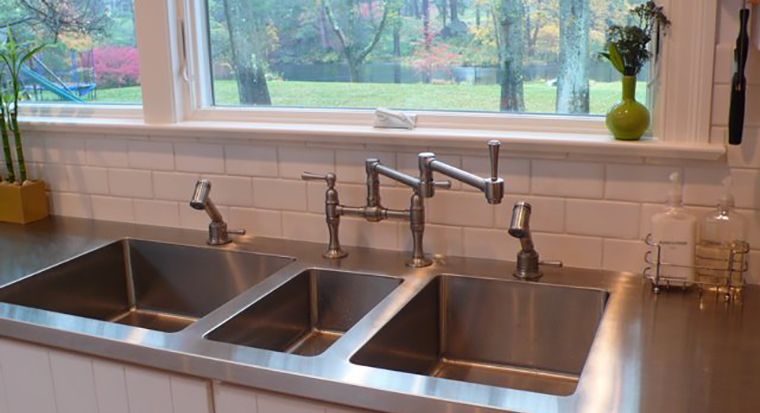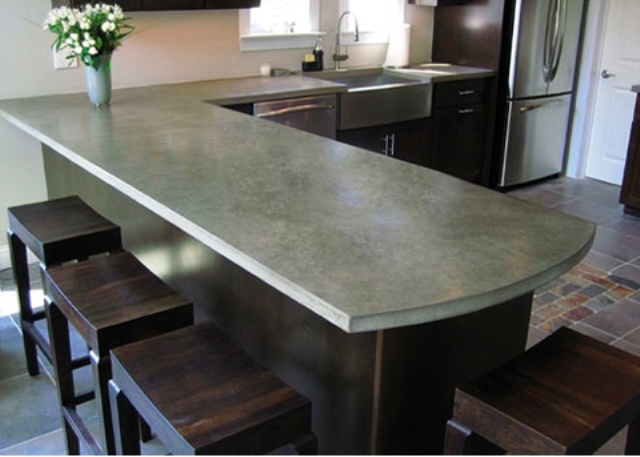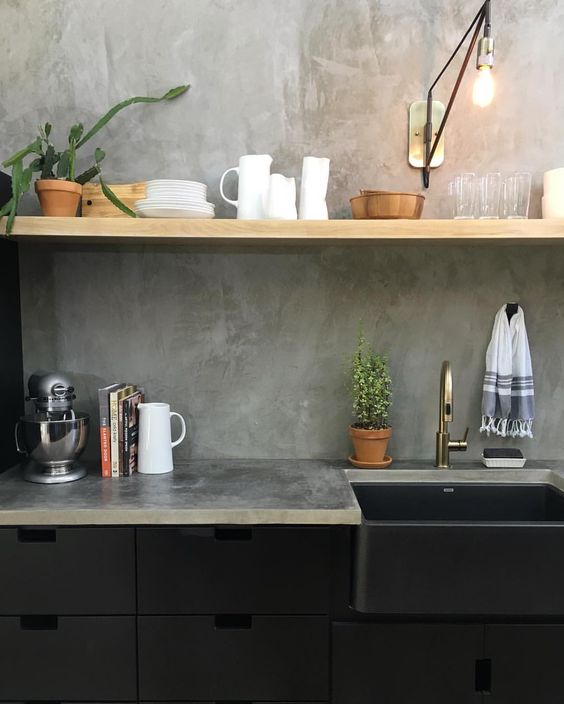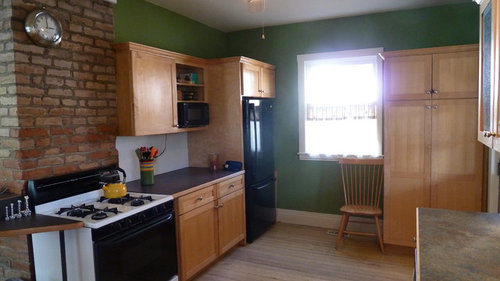The kitchen sink is often the focal point of any kitchen, blending functionality with design to create a space that caters to both cooking and cleaning needs. Selecting the right countertop to accompany your kitchen sink is a significant decision that impacts the room’s overall aesthetic and functionality. The countertop material, color, and design style must work harmoniously with the sink to create a cohesive and practical kitchen. The placement of the sink, its mounting style, and the surrounding countertop area can all enhance how well the space functions. Whether you’re renovating or designing from scratch, understanding your options for countertops can make your kitchen sink area not just efficient but also visually appealing.
Countertops come in a wide range of materials, each offering distinct advantages when paired with kitchen sinks. Granite is a popular choice due to its durability and timeless look. It resists scratches and heat, making it perfect for the heavy use of a kitchen sink area. Granite countertops are versatile enough to match undermount, farmhouse, or drop-in sink styles, providing a seamless and luxurious appearance. Another excellent option is quartz. Known for its non-porous surface and low-maintenance nature, quartz countertops are ideal for busy households. They pair beautifully with modern sinks, offering a sleek and clean finish.

For a more cost-effective yet stylish option, laminate countertops are worth considering. These surfaces have advanced significantly in design, mimicking the look of stone or wood while being more affordable. Laminate is lightweight, which makes it suitable for all sink styles, including heavier farmhouse sinks, as long as proper reinforcement is in place. On the other hand, butcher block countertops provide a warm, natural look, particularly when paired with stainless steel or apron-front sinks. They do require regular sealing to maintain their appearance and resist water damage, but the rustic charm they add to a kitchen is unmatched.
Concrete countertops have grown in popularity for their industrial appeal and customization options. These countertops can be molded to integrate the sink, creating a seamless design. Concrete also allows for various finishes, from polished to matte, and can be tinted to match the overall kitchen palette. However, they require sealing to prevent stains and water damage. Marble countertops, while elegant and luxurious, are less common around kitchen sinks due to their porous nature and susceptibility to staining. Still, with proper care, they can provide an opulent look, especially when matched with high-end sinks.

When choosing a countertop material, the style of sink you plan to install is a critical factor. For undermount sinks, a smooth and level countertop edge is crucial. Materials like quartz or granite are ideal because they offer a polished finish and are durable enough to withstand frequent use. For farmhouse or apron-front sinks, the countertop must align perfectly with the sink’s protruding edge, which means precise measurements and cuts are essential. Drop-in sinks, while easier to install, require a countertop material that can hold the sink’s rim without cracking or sagging.
The color and texture of your countertop also play a major role in your kitchen’s aesthetic. Neutral tones like whites, greys, and beiges are versatile and pair well with stainless steel or ceramic sinks. For a bold look, darker countertops in black or deep green add drama, especially when paired with contrasting sinks in white or metallic finishes. Textured finishes, such as leathered granite or honed quartz, can provide visual interest and a tactile quality to the sink area. However, textured surfaces might require more cleaning to maintain their appearance.

Incorporating practical elements into your countertop design around the sink can elevate your kitchen’s usability. For example, adding a built-in draining board carved into the countertop material next to the sink is both stylish and functional. These grooves direct water back into the sink, keeping the surface dry. Some homeowners opt for integrated cutting boards or prep stations on the countertop adjacent to the sink. These features are not only convenient but also save space and enhance efficiency in smaller kitchens.
For a truly seamless look, consider integrating the sink into the countertop itself. This works particularly well with materials like concrete, stainless steel, or solid surfaces like Corian. These designs eliminate edges where food and debris can accumulate, making cleaning easier. Solid surface countertops, in particular, allow for a molded sink and counter combination that’s sleek and modern. However, they may not be as heat-resistant as other options, so care is needed to avoid placing hot pots or pans on the surface.
The thickness of your countertop is another consideration when pairing it with a kitchen sink. Thicker countertops give a more substantial and luxurious feel but may require customized sinks or mounting hardware to accommodate the added weight. Thinner countertops, while modern and sleek, may need reinforcement to handle heavy sinks like cast iron or fireclay farmhouse designs. The edge profile of the countertop—beveled, bullnose, or waterfall—can also enhance its visual appeal and complement the sink’s style.
When designing your kitchen sink countertop, think about durability and ease of maintenance. Since the sink area is prone to water splashes, soap, and food stains, choosing a material that resists these issues is essential. Quartz and stainless steel offer low-maintenance options, while granite and concrete require periodic sealing to prevent damage. Laminate and wood may need extra care, especially in high-moisture environments. Incorporating backsplash materials that match or contrast with the countertop can also help protect walls and enhance the sink area’s overall look.

Lighting is another overlooked factor in sink countertop design. Task lighting above the sink ensures that you can see clearly when washing dishes or prepping food. Pendant lights, recessed lights, or under-cabinet lighting can all work well in this area. Choose lighting that complements the countertop material’s color and finish to enhance its natural beauty. For example, warm lighting works well with wood or butcher block countertops, while cool lighting highlights the sheen of quartz or granite.
Consider the overall workflow of your kitchen when planning the sink and countertop area. The sink is typically part of the “kitchen triangle,” which also includes the refrigerator and stove. Ensuring that the countertop near the sink has enough space for prep work and dish drying is crucial. In smaller kitchens, installing a single-basin sink with compact countertops can save space while still providing functionality. For larger kitchens, dual-basin sinks with expansive countertops offer ample room for multitasking.
Sustainability is becoming an important consideration in kitchen design. Recycled materials like eco-friendly quartz or reclaimed wood can create beautiful countertops with a reduced environmental footprint. These materials work well with various sink styles and add a unique, personal touch to the kitchen. Sealing and maintenance requirements for sustainable materials are similar to their non-eco counterparts, ensuring that they remain durable and attractive over time.
Last, incorporating personal touches into your kitchen sink countertop area can make it feel uniquely yours. Custom edging, inlays, or integrated features like herb planters or compost bins can add both functionality and charm. Selecting materials and finishes that reflect your lifestyle and taste ensures that your kitchen sink countertop will remain a beloved part of your home for years to come.

Common Mistakes to Avoid
Choosing the Wrong Material: A common mistake is selecting a countertop material that isn’t suited for the kitchen sink area. For instance, opting for porous materials like marble without understanding the maintenance requirements can lead to long-term issues like stains and water damage.
Ignoring Functionality for Style: Some homeowners prioritize aesthetics over practicality, resulting in countertops that are hard to maintain or impractical for daily use. Balance style with usability by considering factors like durability, heat resistance, and ease of cleaning.
Incorrect Measurements: Improper sizing or cutting of the countertop to fit the sink can cause installation headaches. Always double-check measurements, especially for custom sinks like farmhouse or undermount designs.
Neglecting Maintenance Needs: Failing to seal materials like granite, marble, or wood can lead to water damage and stains. Regular upkeep is essential to preserve the countertop’s appearance and longevity.
Poor Workflow Design: Misplacing the sink or failing to provide enough countertop space around it can disrupt kitchen efficiency. Plan for a functional workflow that includes ample prep and drying areas.
Overlooking Lighting: Insufficient lighting near the sink and countertop area can make tasks like dishwashing or food preparation more challenging. Incorporate task lighting to ensure visibility.

What is the best countertop material for a kitchen sink area?
Quartz is one of the best materials due to its non-porous nature, low maintenance, and durability. It resists stains, scratches, and moisture, making it ideal for areas prone to splashes and heavy use. Other excellent choices include granite for its heat resistance and luxurious look or stainless steel for an integrated, industrial-style design. Each material has pros and cons, so the choice depends on your kitchen’s needs and aesthetic preferences.
Can I use wood countertops around a kitchen sink?
Yes, but it requires proper sealing and regular maintenance to prevent water damage and warping. Butcher block countertops, for example, pair beautifully with farmhouse sinks and add warmth to a kitchen. However, they must be treated with a food-safe sealant and cleaned thoroughly after exposure to water to maintain their integrity over time.
How do I integrate a sink into my countertop seamlessly?
Using materials like concrete, solid surface, or stainless steel allows for seamless integration of the sink and countertop. These materials can be molded or fabricated to eliminate edges, making cleaning easier and creating a sleek, modern look. Ensure precise measurements and professional installation for the best results.

Are laminate countertops suitable for undermount sinks?
While laminate is affordable and stylish, it’s not always ideal for undermount sinks because the exposed edges can be vulnerable to water damage. However, with proper sealing and edge treatment, laminate can still work with undermount designs. Consulting a professional during installation can help mitigate potential issues.
What countertop thickness works best with kitchen sinks?
The standard thickness of 2-3 cm works well for most sinks. Thicker countertops offer a more substantial look but may require custom sink fittings and mounting hardware. Always match the sink style with the countertop’s thickness to ensure structural compatibility and visual harmony.
How do I maintain my kitchen sink countertop?
Maintenance depends on the material. Quartz and stainless steel require simple cleaning with mild soap and water, while granite and concrete need periodic sealing to protect against stains. Avoid using harsh chemicals or abrasive scrubbers, as they can damage the surface. Regular cleaning and prompt attention to spills will help maintain the countertop’s appearance and longevity.

1930s kitchen kitchen sink and this wonderful kitchen still with its original vintage 1930s

Quartz Countertops Designs and Colors for Kitchen and Bath Wilsonart White laminate

Concrete Kitchen Backsplashes With Pros And Cons

Need Help with kitchen, I need new countertops, sink and backsplash

Related Posts:
- Laboratory Countertops Kitchen
- Kitchen Countertops Okc
- Can U Paint Kitchen Countertops
- Mid Century Modern Kitchen Countertops
- Kitchen Island Countertop Overhang Support
- Kitchen Laminate Countertops Ideas
- Kitchen Countertop Granite Overlay
- Different Countertops In Same Kitchen
- Kitchen Countertops Knoxville Tn
- Modern Tile Kitchen Countertops